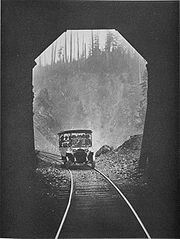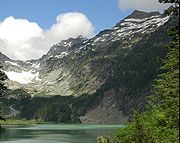
Monte Cristo, Washington
Encyclopedia
Monte Cristo is a ghost town
northwest of Monte Cristo Peak
, in eastern Snohomish County in western Washington.
Prospecting in the region began in the Skykomish River
drainage with the Old Cady Trail used for access. In 1882 Elisha Hubbard improved the trail up the North Fork Skykomish, from Index
to Galena, then north up the tributary Silver Creek. A boom shortly followed at Mineral City. The mineral belt was traced in various directions, including north over the divide between the Skykomish and Sauk River
drainages. In the early summer of 1889 Joseph Pearsall saw glittering deposits and traced them north to Seventysix Gulch and the area that became Monte Cristo. A frenzy of claim staking quickly followed. In 1890 many miners hiked to Monte Cristo from the south by way of Index, Galena, and Mineral City, crossing the divide at first via Wilmans Pass and later via Poodle Dog Pass. In the fall of 1891 a narrow wagon road called the Wilmans or Pioneer Trail was completed from Sauk City on the Skagit River
to Monte Cristo, allowing access from the north. A key stop on this road was the trading post at Orient, at the forks of the Sauk River. Today this area is known as Bedal. In the summer of 1891 it was discovered that Monte Cristo could be accessed via the South Fork Stillaguamish River
. A surveyor named M.Q. Barlow blazed a route from Silverton to Monte Cristo. Mining interests funded further work and soon a wagon road was built over Barlow Pass
to join the Sauk wagon road. Later a railroad would be built over the same route.
Monte Cristo was the first live mining camp on the west slopes of the Cascade Range. There were 13 mines and 40 claims by 1891. By 1893 there were 211 mining claims. The boom required money from the eastern United States to continue to grow. In 1891 John D. Rockefeller
became interested in Monte Cristo. His syndicate, Colby and Hoyt
, took over the primary mines, including the Pride and Mystery mines. The Wilmans brothers were paid $470,000. Rockefeller's companies acquired a controlling two-thirds interest in the best properties.
During the 1890s hopes ran high at Monte Cristo. It was widely believed that the area would become the greatest lead-silver district in the Western Hemisphere. Elaborate cable-bucket aerial tramways were built over Mystery Ridge for hauling ore to the town site, carrying as much as 230 tons every day. A five-level concentrator was completed in 1894 at the Monte Cristo townsite. Ore was shipped out via the newly completed railway, 42 miles long from Monte Cristo to Hartford. The boom peaked in 1894, at which time the town's population was well over 1,000. In 1895 there were 125 men employed in the mines with a monthly payroll of $10,500. Employment rose to 200 in 1896. Mining activity indirectly supported about 600 people.
The year 1896 was prosperous but in November major flooding damaged or destroyed railroad tunnels and track. Mining output reached record levels in 1897 but again intense autumn floods devastated the region's infrastructure, the repair of which cut deeply into mining profits. Other problems such as metallic impurities at the Monte Cristo concentrator and the Everett smelter led to the boom collapsing. By 1900 most of the Monte Cristo miners had left for the new mining booms of the Klondike
.
Miners and geologists had made mistakes in judging the potential of Monte Cristo's mineral wealth. There were rich surface deposits but they did not continue far into the ground. Mining below about 500 feet turned out to be seldom worth the effort. Mining operations ceased in 1907, probably related to the Panic of 1907
. The town survived as a tourist destination for several more decades, but the county road was flooded out in 1980, and the only remaining business in town, a lodge, burned down in 1983.
Very few original structures are still standing, but the four-mile-long road (as noted in driving directions) into town remains popular with hikers and mountain bikers.


Ghost town
A ghost town is an abandoned town or city. A town often becomes a ghost town because the economic activity that supported it has failed, or due to natural or human-caused disasters such as floods, government actions, uncontrolled lawlessness, war, or nuclear disasters...
northwest of Monte Cristo Peak
Monte Cristo Peak
Monte Cristo Peak is a mountain peak in the Henry M. Jackson Wilderness in Washington state. Together with Columbia Peak and Kyes Peak it forms a basin that contains Columbia Glacier and Blanca Lake...
, in eastern Snohomish County in western Washington.
Prospecting in the region began in the Skykomish River
Skykomish River
The Skykomish River is a Washington river which drains the west side of the Cascade Mountains in the southeast section of Snohomish County and the northeast corner of King County. The river starts with the confluence of the North Fork Skykomish River and South Fork Skykomish River approximately one...
drainage with the Old Cady Trail used for access. In 1882 Elisha Hubbard improved the trail up the North Fork Skykomish, from Index
Index, Washington
Index is a town in Snohomish County, Washington, United States. The population was 178 at the 2010 census.-History:Prior to settlement by westerners, the Skykomish Indians lived in the area between Sultan and Index...
to Galena, then north up the tributary Silver Creek. A boom shortly followed at Mineral City. The mineral belt was traced in various directions, including north over the divide between the Skykomish and Sauk River
Sauk River
Sauk River can refer to the following rivers in the United States:*Sauk River *Sauk River , a tributary of the Mississippi River*Sauk River , a tributary of the Skagit River...
drainages. In the early summer of 1889 Joseph Pearsall saw glittering deposits and traced them north to Seventysix Gulch and the area that became Monte Cristo. A frenzy of claim staking quickly followed. In 1890 many miners hiked to Monte Cristo from the south by way of Index, Galena, and Mineral City, crossing the divide at first via Wilmans Pass and later via Poodle Dog Pass. In the fall of 1891 a narrow wagon road called the Wilmans or Pioneer Trail was completed from Sauk City on the Skagit River
Skagit River
The Skagit River is a river in southwestern British Columbia in Canada and northwestern Washington in the United States, approximately 150 mi long...
to Monte Cristo, allowing access from the north. A key stop on this road was the trading post at Orient, at the forks of the Sauk River. Today this area is known as Bedal. In the summer of 1891 it was discovered that Monte Cristo could be accessed via the South Fork Stillaguamish River
Stillaguamish River
The Stillaguamish River is a river in northwest Washington in the United States. It is mainly composed of two forks, the longer North Fork Stillaguamish and the South Fork Stillaguamish. The two forks join near Arlington. From there the Stillaguamish River proper flows for to Puget Sound...
. A surveyor named M.Q. Barlow blazed a route from Silverton to Monte Cristo. Mining interests funded further work and soon a wagon road was built over Barlow Pass
Barlow Pass (Washington)
Barlow Pass is a mountain pass on the west side of the Cascades in Washington on the Mountain Loop Highway between Silverton and Darrington...
to join the Sauk wagon road. Later a railroad would be built over the same route.
Monte Cristo was the first live mining camp on the west slopes of the Cascade Range. There were 13 mines and 40 claims by 1891. By 1893 there were 211 mining claims. The boom required money from the eastern United States to continue to grow. In 1891 John D. Rockefeller
John D. Rockefeller
John Davison Rockefeller was an American oil industrialist, investor, and philanthropist. He was the founder of the Standard Oil Company, which dominated the oil industry and was the first great U.S. business trust. Rockefeller revolutionized the petroleum industry and defined the structure of...
became interested in Monte Cristo. His syndicate, Colby and Hoyt
Colgate Hoyt
Colgate Hoyt was an American businessman active in the late nineteenth century. He was a director of the Oregon Railway and Navigation Company, and one of the founders of Everett, Washington, where a main street is named after him. He was a New York investment banker who was the partner of Joseph...
, took over the primary mines, including the Pride and Mystery mines. The Wilmans brothers were paid $470,000. Rockefeller's companies acquired a controlling two-thirds interest in the best properties.
During the 1890s hopes ran high at Monte Cristo. It was widely believed that the area would become the greatest lead-silver district in the Western Hemisphere. Elaborate cable-bucket aerial tramways were built over Mystery Ridge for hauling ore to the town site, carrying as much as 230 tons every day. A five-level concentrator was completed in 1894 at the Monte Cristo townsite. Ore was shipped out via the newly completed railway, 42 miles long from Monte Cristo to Hartford. The boom peaked in 1894, at which time the town's population was well over 1,000. In 1895 there were 125 men employed in the mines with a monthly payroll of $10,500. Employment rose to 200 in 1896. Mining activity indirectly supported about 600 people.
The year 1896 was prosperous but in November major flooding damaged or destroyed railroad tunnels and track. Mining output reached record levels in 1897 but again intense autumn floods devastated the region's infrastructure, the repair of which cut deeply into mining profits. Other problems such as metallic impurities at the Monte Cristo concentrator and the Everett smelter led to the boom collapsing. By 1900 most of the Monte Cristo miners had left for the new mining booms of the Klondike
Klondike, Yukon
The Klondike is a region of the Yukon in northwest Canada, east of the Alaska border. It lies around the Klondike River, a small river that enters the Yukon from the east at Dawson....
.
Miners and geologists had made mistakes in judging the potential of Monte Cristo's mineral wealth. There were rich surface deposits but they did not continue far into the ground. Mining below about 500 feet turned out to be seldom worth the effort. Mining operations ceased in 1907, probably related to the Panic of 1907
Panic of 1907
The Panic of 1907, also known as the 1907 Bankers' Panic, was a financial crisis that occurred in the United States when the New York Stock Exchange fell almost 50% from its peak the previous year. Panic occurred, as this was during a time of economic recession, and there were numerous runs on...
. The town survived as a tourist destination for several more decades, but the county road was flooded out in 1980, and the only remaining business in town, a lodge, burned down in 1983.
Very few original structures are still standing, but the four-mile-long road (as noted in driving directions) into town remains popular with hikers and mountain bikers.



